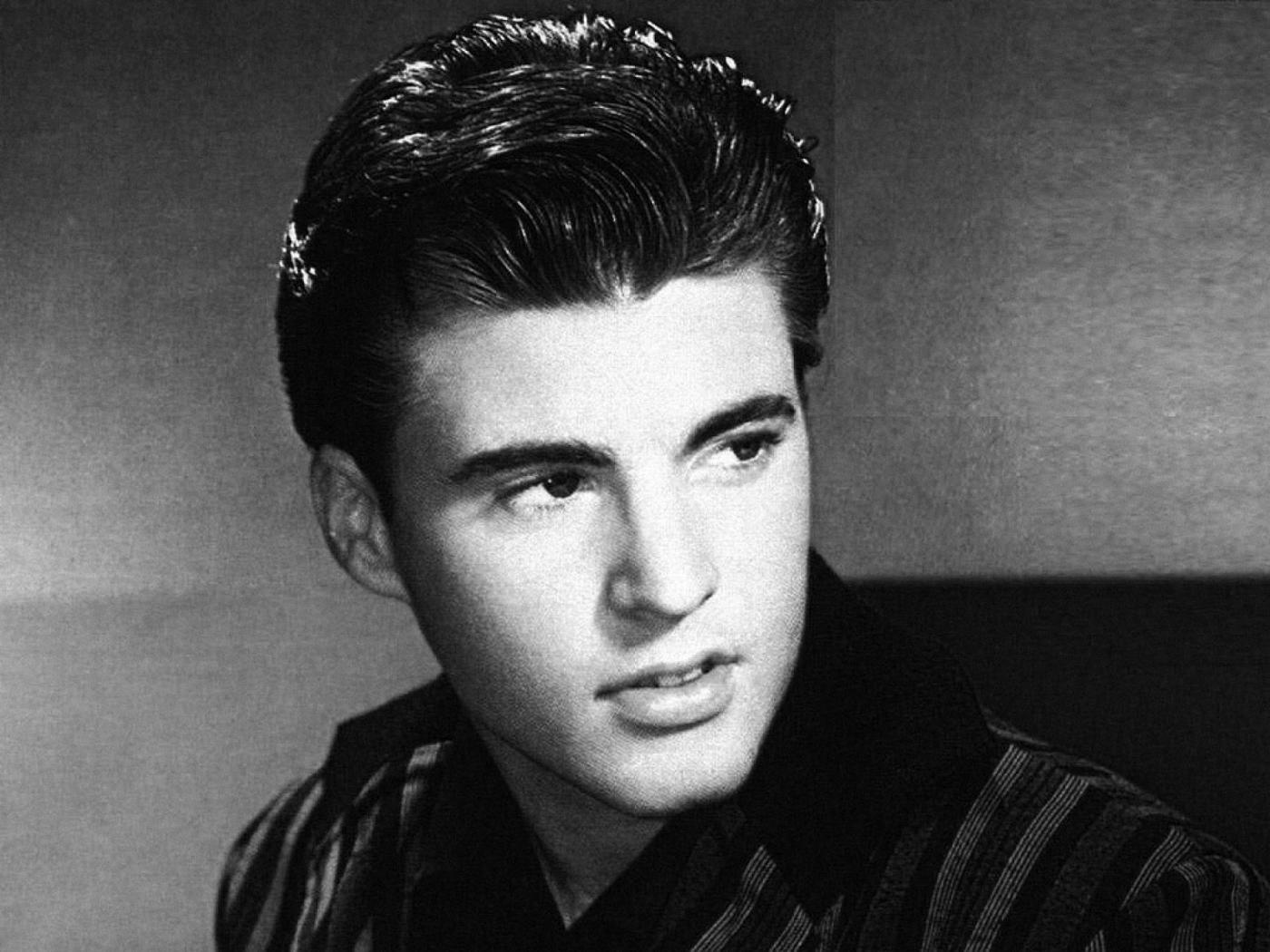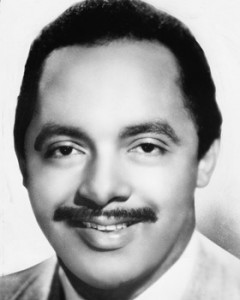Fifty-seven years ago this week, Ricky Nelson (top) sat at #1 on Billboard Magazine’s first Hot 100 chart, which offered a new way of tabulating the popularity of music recordings. The Hot 100 was in fact preceded by a chart called “Top 100 Sides” that showed the Perez Prado Orchestra (above) at #1 the previous week with Ricky Nelson knocking on the door. (Scroll to bottom for chart).
Commentary by Rick Hiduk
Rankings of various aspects of pop culture, such as music, movies, and books, have become a mainstay of collective knowledge for the last half century, but collecting and assigning such figures to positions on charts was already a routine practice in the business world for eons before that. Trade magazines of various sorts began popping up in the mid 1890s, Billboard Magazine making its debut in November 1894.
By the 1950s, the New York-based trade publication had developed a complex methodology for tabulating the popularity of music in its many forms, including sheet music sales. Only singles (two-sided 7- and 10-inch vinyl or acetate discs) were charted initially, even though 33 rpm long-play albums (lps) had been available since the early ’50s. There would not be an album chart until 1963. This information was compiled primarily for people in the industry and not necessarily for the public.
The public was nonetheless intrigued by #1 hits and “gold” records, owing to the popularity of radio and TV shows like Your Hit Parade, on which several singers would croon their way through the ten most popular songs of the week. American Bandstand also sported a Top Ten board, and Dick Clark would showcase it each week as the kids danced to the #1 song. Casey Kasum used the top 40 songs from the Hot 100 as the basis for his American Top 40 countdown, starting in 1970.
In 1958, Billboard was publishing three charts devoted to popular music, which covered all genres – big band, rock ‘n’ roll, R&B, country & western, and jazz – simultaneously. “Best Selling Pop Singles in Stores” was a sales chart with fifty positions. “Most Played by Jockeys” was a Top 25 list based on radio airplay.
The third chart – “Top 100 Sides” – was the magazine’s first attempt at combining some of the aforementioned data with jukebox play and “requests by customers” at record stores for specific titles. This allowed A and B sides to be shown on the chart at two different positions. Some artists – such as Elvis Presley, the Beach Boys, the Beatles, the Rolling Stones, the Guess Who and CCR – excelled at two-sided hits.
The new Hot 100, introduced on Monday, Aug. 4, 1958, raised the bar for charting the popularity of recorded music by networking weekly data entries from radio stations, retail outlets, and jukebox operators from select venues across the country concurrently. It immediately replaced the old Top 100, and the sales chart was discontinued two months later.
These significant changes held forth for another thirty years, successfully imitated for a few decades by Billboard’s long-time rival Cashbox Magazine. Due to growing speculation by the late 1980s that the charts were being manipulated by the record companies (which had been true since the inception of the charts), Billboard made a radical shift in late 1991 to compiling airplay and sales data by BDS and SoundScan, software systems that provided much more accurate information but created stale and stagnant charts on which songs still linger for 40 or more weeks, once an anomaly.
Regardless of the date of the chart or the methodology used to compile it, each weekly list captures a moment in time. Looking back on old music charts brings memories about family and friends, as well as weather events and the state of the economy. In 1958, America was enjoying a stretch of relative calm and prosperity under President Ike Eisenhower. It was a good time to be a white American, while black Americans were becoming increasingly impatient with the inequities they faced. Ironically, many black performers were enjoying enormous popularity among white audiences, even though their hits were often covered and watered down by white artists.
In 1958, rock ‘n’ roll, which had almost overrun the charts in 1957, was beginning to suffer backlash. The famous “payola” trials were underway during which many disc jockeys and record company promo reps were accused of being in cahoots. Parents were beginning to suspect that rock ‘n’ roll was the root of all evil, and advertisers threatened to cancel contracts with radio stations that play too much of it.
Nonetheless, there is great rock ‘n’ roll and some jumping R&B in the top ten of the first Hot 100. Bobby Darin’s “Splish Splash” is at #3, Elvis Presley’s “Hard Headed Woman” is inching downward at #4, Duane Eddy’s “Rebel-‘Rouser” is at #6, and the Coasters and the Johnny Otis Show are at #7 and #9, respectably, with “Yakety Yak” and “Willie & the Hand Jive.” The latter must have been bigger on the radio and in malt shops, because Johnny Otis is only at #16 on the sales chart.
The only cover in the top ten is Peggy Lee with “Fever,” an R&B hit for Little Willy John in 1954. Unlike most covers of black hits at the time, which were essentially remakes, Lee’s jazzy take on “Fever” stood on its own merits and endured as a perennial lounge classic.
Ricky Nelson was at #1 for the first time in his young career with “Poor Little Fool,” his sixth top five hit and the first to reach the top. Featured weekly on the “Ozzie & Harriet Show,” TV star Ricky Nelson was more from the “teen idol” mold than that of the bawdy rockers His squeaky clean good looks made him acceptable to parents and attractive to teens. He would not hit #1 one again though until 1961 with “Travelin’ Man.”
The remainder of the top ten includes Latin band leader Perez Prado with his second #1 pop hit, “Patricia;” one-hit wonders The Kalin Twins with “When;” and Canadian-American singer-songwriter Jack Scott with the baritone ballad “My True Love.”
A slight phenomena was hidden by the publication of the first Hot 100 in the fact that all 100 songs listed were shown as “new” and in their first week on the chart. In fact, the Italian version of “Volare (Nel Blu Dipinto di Blu)” by Domenico Modugno was truly making its chart debut at #54, as was Dean Martin’s mixed-language version of the same song at #68. The next week, Modugno would surge to #2 with Martin also jumping into the Top Forty at #38. The all-Italian version spent five of the next six weeks at #1. Martin, who had other hits on the charts simultaneously, peaked at #12.
Ten Most Popular Songs in America from the Billboard Magazine Hot 100, dated August 4, 1958.
- Poor Little Fool – Ricky Nelson (https://www.youtube.com/watch?v=R12H8QWnwvE )
- Patricia – Perez Prado (https://www.youtube.com/watch?v=f0A6KCLO_54 )
- Splish Splash – Bobby Darin (https://www.youtube.com/watch?v=QSA-yHzkvP8 )
- Hard Headed Woman – Elvis Presley (https://www.youtube.com/watch?v=lEoToCgmOOE )
- When – Kalin Twins (https://www.youtube.com/watch?v=UAM6QkpVIJg )
- Rebel-‘Rouser – Duane Eddy (https://www.youtube.com/watch?v=uGPG_Y-_BZI )
- Yakety Yak – The Coasters (https://www.youtube.com/watch?v=lXgzQQ5XsHc )
- My True Love – Jack Scott (https://www.youtube.com/watch?v=8dTr_3S7fqo )
- Willie and the Hand Jive – the Johnny Otis Show (https://www.youtube.com/watch?v=zUyP9bBEutM )
- Fever – Peggy Lee (https://www.youtube.com/watch?v=X7_k_0dKknA )

